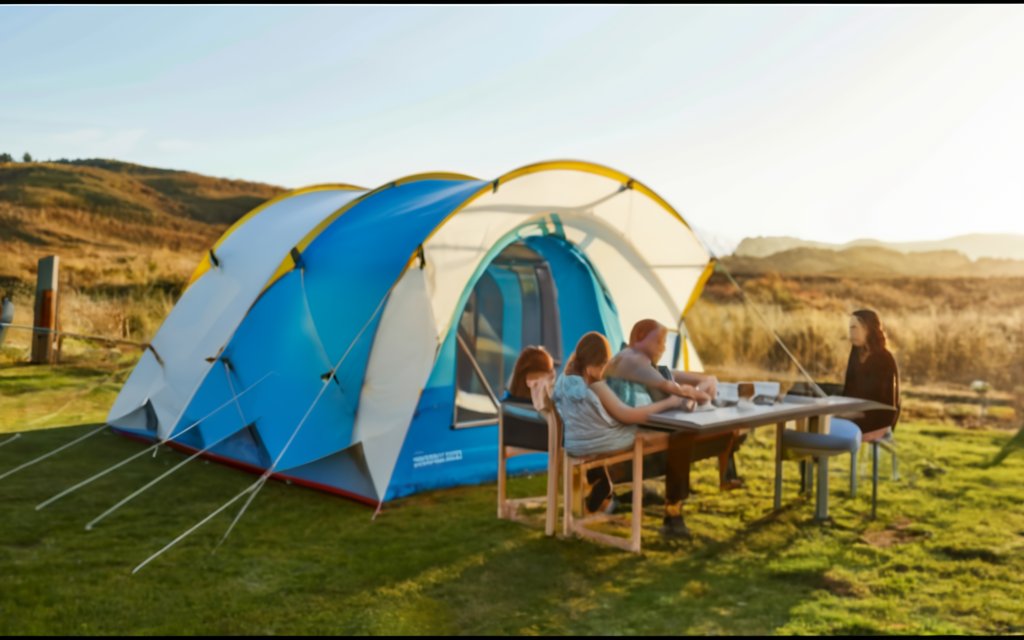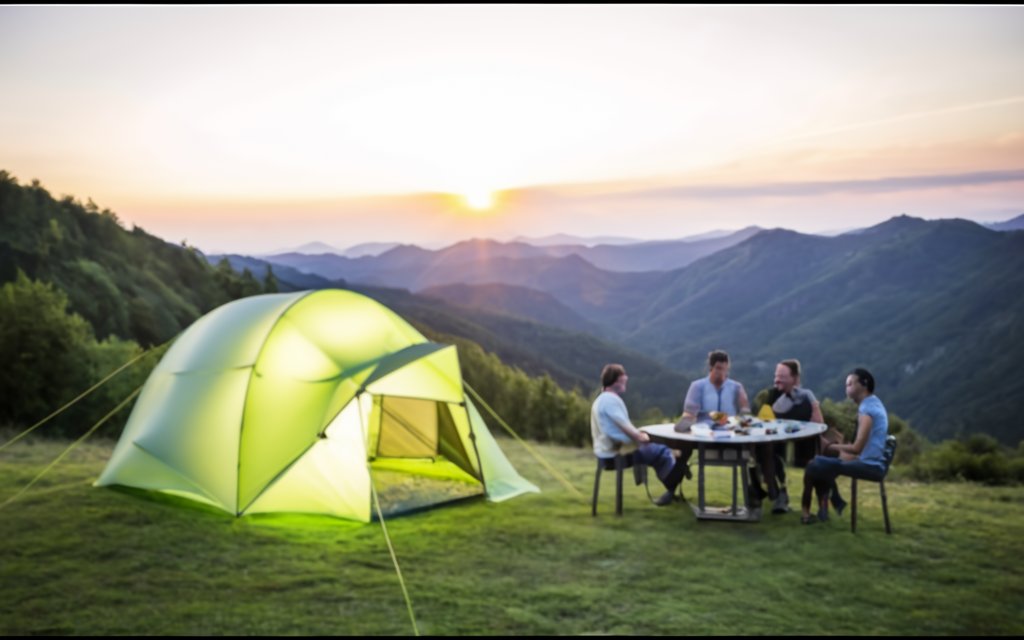
When it comes to camping, one of the most exciting aspects is cooking and dining in the great outdoors. And if you’re camping with an inflatable tent, it opens up a whole new world of possibilities for your culinary adventures. Whether you’re a seasoned outdoor chef or a beginner looking to try something new, we have some practical advice to help you make the most of your cooking and dining experience in an inflatable tent.
Key Takeaways:
- Prepare camping meals and explore outdoor cooking with campfire recipes.
- Create a portable kitchen setup in your inflatable tent for convenient dining.
- Discover camping food hacks and meal prep tips for a seamless culinary experience.
The Dangers of Cooking in a Tent
When it comes to cooking in a tent, there are several significant dangers that campers need to be aware of and take precautions against. The very act of cooking inside a tent increases the risk of fire, burns, carbon monoxide poisoning, and an unstable cooking setup.
Tent Fire Hazards: Tents made of flammable materials pose a serious fire hazard. In the event of a cooking mishap, such as spilled fuel or sudden fireballs from cooking equipment, the tent can quickly catch fire, endangering both the occupants and nearby structures.
Burns: Cooking inside a tent introduces the risk of burns due to the close proximity of open flames or hot surfaces. Accidental contact with a hot stove, utensils, or boiling liquids can cause severe burns, which can be painful, long-lasting, and potentially life-threatening.
Carbon Monoxide Poisoning: Cooking in a sealed tent without proper ventilation can lead to the accumulation of carbon monoxide, an odorless and potentially lethal gas. The symptoms of carbon monoxide poisoning include headache, shortness of breath, dizziness, disorientation, and stomach pains, and if left untreated, it can be fatal.
Unstable Canister and Burner: Uneven tent floors can lead to an unstable cooking setup, especially when using canister stoves or burners. Without a stable base, there is a higher risk of accidental spills or tipping of the stove, which can cause burns or start a fire.
Minimizing the Risks
To ensure safe cooking practices in a tent, campers should prioritize the following precautions:
1. Always cook outside the tent whenever possible to eliminate the risk of fire and carbon monoxide buildup.
2. If cooking inside the tent is unavoidable, use a tent made of non-flammable materials and ensure proper ventilation to minimize the risk of fire and carbon monoxide poisoning.
3. Keep the cooking area clear of flammable objects and use flame retardant mats to protect the tent floor from accidental spills or fireballs.
4. Place the stove or burner in the center of the tent, on a stable surface, and away from flammable materials or walls.
5. Regularly inspect and maintain the cooking equipment to ensure it is in good working condition and follows manufacturer guidelines.
6. Be mindful of the cooking environment and avoid using stoves or burners in windy conditions that could increase the risk of fire or instability.
By understanding and addressing the dangers associated with cooking in a tent, campers can take the necessary steps to mitigate risks and enjoy a safe camping experience.
Choosing the Right Location for Your Inflatable Tent
When planning your camping trip with an inflatable tent, selecting the right location is crucial for a successful and enjoyable experience. Consider these factors to ensure you choose a suitable spot that aligns with your needs and ensures a safe and comfortable stay.
Terrain and Stability
Opt for a flat and even surface for pitching your inflatable tent. This will provide stability and prevent any discomfort caused by uneven ground. Avoid areas with sharp rocks or debris that may puncture or damage your tent.
Natural Shelter
Look for locations that offer natural shelter, such as trees or rocks. These natural structures can provide protection from strong winds and heavy rain, keeping you and your tent safe and dry.
Water Sources
Proximity to water sources is essential for camping. Choose a location near streams, lakes, or other water bodies, ensuring easy access to clean water for drinking, cooking, and cleaning. This will enhance your overall camping experience.
Sun Exposure
Consider the sun exposure of a potential campsite. Evaluate whether you prefer a shaded spot or ample sunlight throughout the day. This will help you create a comfortable and enjoyable outdoor environment based on your personal preferences.
Local Regulations
Ensure that you respect and adhere to local regulations and camping guidelines. Different regions may have specific rules regarding camping, campfire usage, and tent placement. Familiarize yourself with these regulations to avoid any legal issues and maintain a respectful camping experience.
By evaluating the terrain, seeking natural shelter, considering water sources and sun exposure, and respecting local regulations, you can confidently choose the perfect location for your inflatable tent camping adventure.
Staying Warm and Cozy in Your Inflatable Tent
To ensure a comfortable camping experience, staying warm in an inflatable tent is essential. With the right gear and preparation, you can create a cozy sleeping environment even in chilly temperatures.
Investing in proper insulation gear is crucial. Equip yourself with a thermal sleeping bag, which provides excellent insulation against the cold. Additionally, using a sleeping pad or air mattress will prevent the cold ground from sapping your body heat.
Proper ventilation is another important factor to consider. While it may seem counterintuitive, ventilation helps reduce condensation inside the tent and maintains a pleasant temperature. Look for tents with adjustable ventilation options such as mesh windows or vents, which allow for regulating airflow.
For added warmth, there are portable heaters designed specifically for tents. These heaters provide a reliable source of heat while ensuring safety. However, always follow the manufacturer’s instructions and never leave a heater unattended.
If you prefer alternatives to portable heaters, consider using hot water bottles or heated blankets. These items are easy to pack and can provide comforting warmth throughout the night. Just make sure to use them responsibly and follow the safety guidelines.
Remember to prioritize safety and be mindful of fire hazards. Keep all heating devices away from flammable materials and ensure proper ventilation to prevent carbon monoxide build-up.
Packing and Transporting Your Inflatable Tent

When it comes to packing up your inflatable tent, proper deflation is the first step to ensure a smooth and hassle-free process. Begin by unzipping all the doors and windows of the tent to release the air inside. This will make folding and packing much easier.
Next, carefully fold the tent accordion-style, following its original creases or seams. Take your time to make sure the folds are neat and even. Be sure to fold any protruding poles or frames to prevent them from getting damaged during transportation.
To protect your inflatable tent from moisture and other potential hazards during transportation, consider investing in a waterproof bag or storage container specifically designed for camping gear. These specialized bags provide an extra layer of protection, keeping your tent dry and safe from the elements.
Before placing the tent in its storage bag or container, take a moment to remove any debris that may have accumulated. This will help prevent any dirt or sharp objects from causing damage. It’s also crucial to ensure even weight distribution within your backpack or vehicle to maintain balance and stability during transport.
Remember, proper packing and storage of your inflatable tent not only protects it from damage but also ensures that it remains in top condition for your next camping adventure.
Conclusion
Camping with an inflatable tent can provide a unique and exhilarating outdoor experience. By following practical tips for cooking and dining in a tent, understanding the potential dangers, choosing the right location, staying warm, and packing effectively, you can ensure a safe and enjoyable camping trip.
It is crucial to prioritize safety during your camping adventures. By adhering to local regulations and being aware of the potential risks associated with cooking in a tent, you can minimize the chances of accidents or injuries. Additionally, being prepared for unexpected situations, such as sudden changes in weather or equipment malfunctions, is essential.
With proper planning and preparation, cooking and dining in an inflatable tent can be a fun and rewarding experience. From delicious campfire recipes to convenient camping food hacks, you can enjoy delicious meals in the great outdoors. Remember to choose a suitable location, stay warm with proper insulation gear, and pack your tent carefully to ensure its longevity.
So go ahead and embark on your camping journey with an inflatable tent. Immerse yourself in nature, breathe in the fresh air, and create lasting memories around the campfire. Whether you are a seasoned camper or a beginner, camping with an inflatable tent offers a sense of adventure and a chance to reconnect with the beauty of the natural world.
Recommended
- BEST BED TENT TO BLOCK OUT LIGHT FOR SLEEP
- BED TENT FOR TRAVEL: SLEEP COZY ON-THE-GO
- INDOOR BED TENT FOR CAMPING COMFORT & FUN

Meet Noah, the soul behind “Best Inflatable Tent” and a true wanderer at heart. Living the van life, Noah has turned his passion for exploring the great outdoors into a lifestyle, earning his living through organizing group travels that bring people closer to nature. With years of firsthand experience in the wild, Noah’s expertise in selecting and utilizing inflatable tents is unparalleled. Through this blog, he shares his profound knowledge and practical tips to help fellow adventurers find their perfect outdoor shelters. Noah’s commitment to delivering genuine, tested insights has made him a trusted authority in the camping community. Join him on this journey to discover the best inflatable tents that make the great outdoors feel like home.